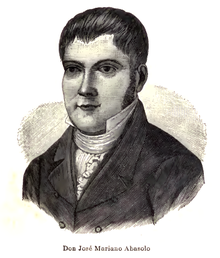Mariano Abasolo
José Mariano de Abasolo Outón (* 1783 in Dolores , Mexico , † April 14, 1816 in Cádiz , Spain ) was a Mexican revolutionary who supported the Mexican side in the Mexican War of Independence .
Life
Mariano Abasolo was born in Dolores in the province of Guanajuato in 1783 . He came from a family of wealthy landowners; his father was named José Abasolo, his mother Mariela (according to other sources: Micaela) Outón. The wealth of his family gave Mariano the prospect of a materially carefree life.
He joined a dragoon regiment of the Spanish army in Mexico and in 1806 reached the rank of captain. Its stationing changed between San Miguel el Grande and Mexico City . By marrying María Manuela de Rojas Taboada de Chamacuero, who came from a wealthy landowning family, he once again increased his fortune significantly.
In the garrison of San Miguel, Mariano Abasolo met the commander of a cavalry regiment named Ignacio Allende and was introduced by him to the Valladolid conspiratorial circle around Miguel Hidalgo , Josefa Ortiz de Domínguez and Juan Aldama , who wanted to lead Mexico to independence.
The original plan was to start the military uprising against the Spaniards from October 1, 1810. The plan was betrayed to the Spaniards, so that on September 16, 1810, Miguel Hidalgo gave the signal for the revolt with the cry of Dolores (Spanish: Grito de Dolores ). Abasolo was appointed captain in the insurgent army and received the first order to secure the weapons and ammunition from Dolores for the rebels.
Abasolo took part in the insurgent campaign without always fighting on the front lines. With his considerable financial means he was able to support the Mexicans materially. When Allende was proclaimed lieutenant general of the rebel army in Celaya , Abasolo received the rank of colonel. He was not personally present when the Alhóndiga de Granaditas was attacked in Guanajuato .
In October he was given the rank of field marshal and commanded a wing of the Mexicans in the victorious battle of Monte de las Cruces . The Spanish general Félix María Calleja del Rey put a price on Abasolo's head.
When, after the victory of Monte de las Cruces, the insurgents hesitated to attack the capital, Mexico City, and the fortunes of the battle turned, Abasolo and the leaders of the movement withdrew towards Guanajuato.
After the rebels' devastating defeat at the Battle of Puente de Calderón in January 1811, officers attempted to escape north to seek US support . Allende wanted to appoint Abasolo commander in chief of the remaining force, but Abasolo refused.
This was apparently also done out of consideration for his wife, who had come to Saltillo and from there wrote a petition for clemency to General Calleja.
The leaders of the independence movement were betrayed in March 1811 to the Spaniards who they captured in Acatita de Baján . Abasolo was brought to Chihuahua with Juan Aldama , José Mariano Jiménez and Manuel Santa María , where they were tried.
At the trial, Abasolo put responsibility for the uprising on Allende and Hidalgo; Because of this statement and his wife's continued petitions for clemency, Mariano Abasolo was not sentenced to death, but only to life imprisonment. He was supposed to be serving his sentence in Spain. The Spanish crown confiscated his property and sent him and his wife to Spain in 1812.
There he died of tuberculosis on April 14, 1816 in the prison of the fortress Santa Catalina in Cádiz.
literature
- Isidro Vizcaya Canales: En los albores de la Independencia: las Provincias Internas durante la insurrección de don Miguel Hidalgo y Costilla, 1810-1811 . Fondo Editorial Nuevo León, Monterrey, Mexico 2005, ISBN 970-9715-04-6 ( limited preview in Google Book Search [accessed February 3, 2016]).
Web links
| personal data | |
|---|---|
| SURNAME | Abasolo, Mariano |
| ALTERNATIVE NAMES | Abasolo Outón, José Mariano de (full name) |
| BRIEF DESCRIPTION | Mexican revolutionary |
| DATE OF BIRTH | 1783 |
| PLACE OF BIRTH | Dolores Hidalgo , Mexico |
| DATE OF DEATH | April 14, 1816 |
| Place of death | Cadiz , Spain |
